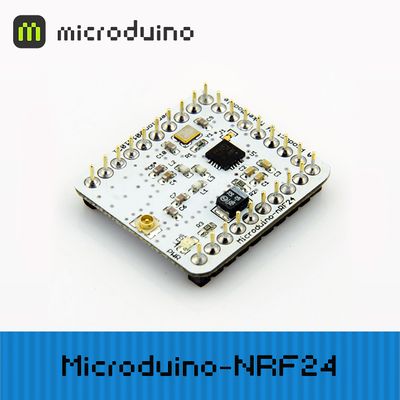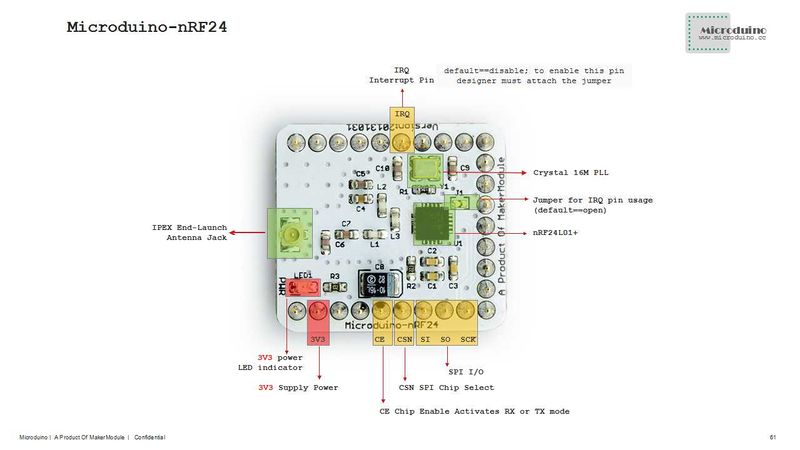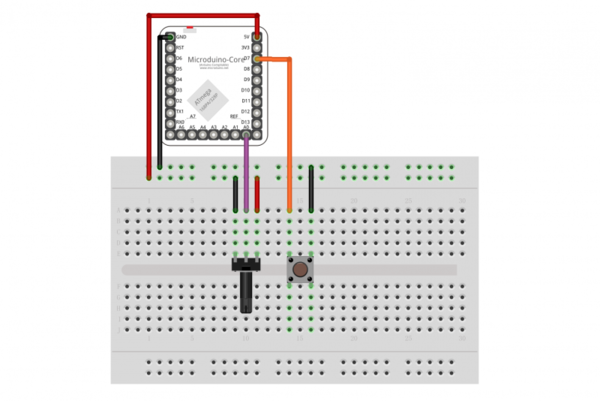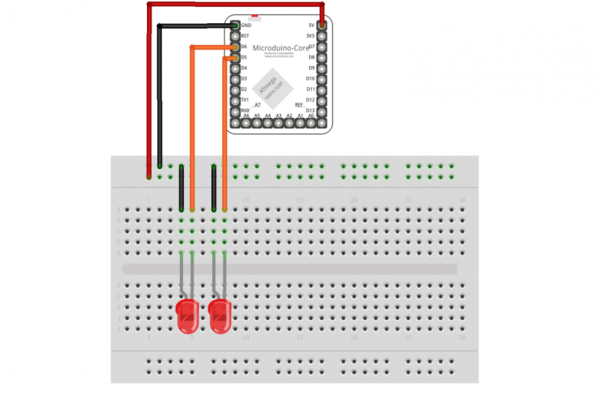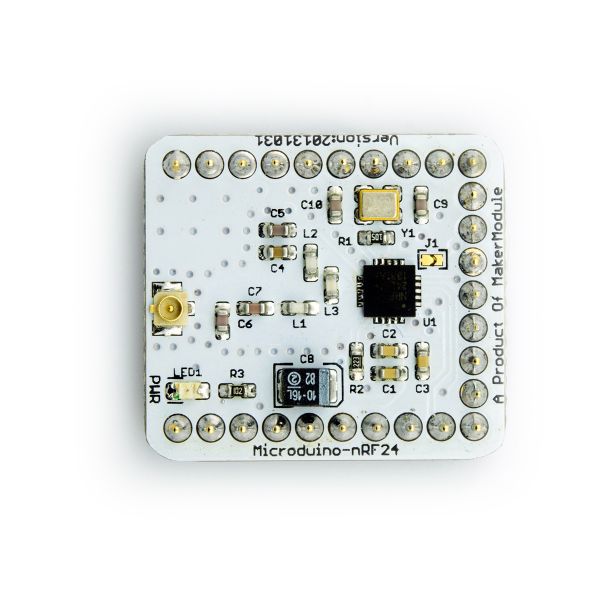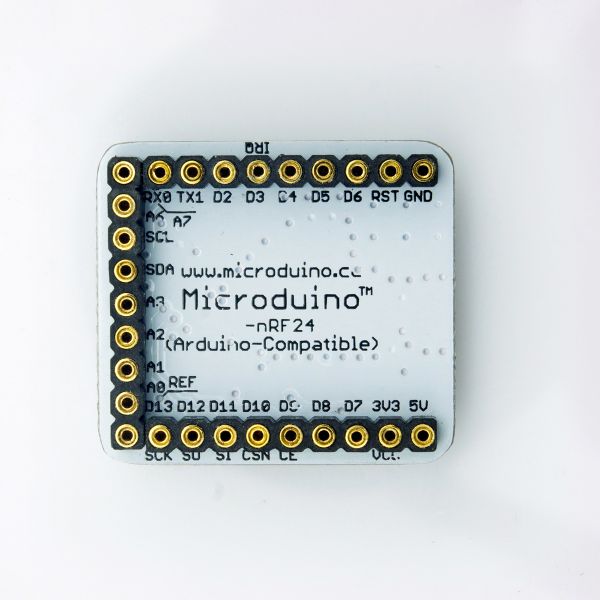Difference between revisions of "Microduino-Module nRF"
From Microduino Wiki
(→Specifications) |
|||
| (19 intermediate revisions by 6 users not shown) | |||
| Line 1: | Line 1: | ||
| + | {{Language|Microduino-nRF24}} | ||
{| style="width: 800px;" | {| style="width: 800px;" | ||
|- | |- | ||
| | | | ||
[[file:Microduino-nRF-rect.jpg|400px|thumb|right|Microduino-nRF24]] | [[file:Microduino-nRF-rect.jpg|400px|thumb|right|Microduino-nRF24]] | ||
| − | + | Microduino-nRF24 is a high-speed embedded wireless data transmission module. | |
| − | |||
| − | |||
| − | |||
| − | |||
| − | |||
| − | |||
| − | |||
|- | |- | ||
| | | | ||
==Features== | ==Features== | ||
| − | * | + | *Fully integrated link layer on the module makes it easy to develop. |
| − | * | + | *With automatic retransmission function, it can automatically detect and resend lost packets and the retransmission time and frequency can be controlled by software. |
| − | + | *With packets that can automatically save un-received response signals. | |
| − | * 2.54mm (0.1 inch) pin pitch, compatible | + | *With automatic reply function, the module can send response signal automatically after receiving valid data and need no reprogramming. |
| + | *Capable of setting six receiving channels' address synchronously and opening the receiving channels selectively. | ||
| + | *Standard pin 2.54mm spacing interface, making it convenient for embedded application. | ||
| + | *Small, stackable and economic. | ||
| + | *Open source hardware circuit design and Arduino compatible programming development environment. | ||
| + | *With a uniform Microduino interface standard and rich peripheral modules, it can easily connect with other Microduino modules and sensors. | ||
| + | *2.54mm(0.1 inch) pin pitch, compatible with bread boards and pegboards. | ||
| + | ==Specification== | ||
| + | *Global open 2.4GHz ISM band with the maximum transmission power of 0DBM and free license to use. | ||
| + | *Low operation voltage: 1.9-3.6 V. | ||
| + | *SMA antenna, easy to change. | ||
| + | *Support six channels' data transmission. | ||
| + | *High rate: 2MBPS. Due to short transmission rate in the air, it largely reduces collision in wireless transmission. (Set 2MBPS or 256 KBPS, 1 MBPS air transmission rate with software) | ||
| + | *Multi-point frequency: With 125 frequency points, it meets the requirement of multi-point communication and frequency hopping communication. | ||
| + | *Low consumption: With fast air transmission and startup, it greatly reduces the current consumption when communicating in the response mode. | ||
| − | + | ===Pin Description=== | |
| − | |||
| − | == | ||
| − | |||
| − | |||
| − | |||
| − | |||
| − | |||
| − | |||
| − | |||
| − | |||
:[[file:Micrduino-nRF24-1.jpg|800px|thumb|center|Microduino-nRF24 Spec]] | :[[file:Micrduino-nRF24-1.jpg|800px|thumb|center|Microduino-nRF24 Spec]] | ||
<br style="clear: left"/> | <br style="clear: left"/> | ||
| + | {|class="wikitable" | ||
| + | ! rowspan="1" | NRF24L01 Pin || Microduino Pin || Function | ||
| + | |- | ||
| + | | SCK|| D13 || SPI bus clock | ||
| + | |- | ||
| + | | SI || D12 || Data input pin | ||
| + | |- | ||
| + | | SO || D11 || Data output pin | ||
| + | |- | ||
| + | | CSN || D10 || SPI Chip-select signal (Defined in program) | ||
|- | |- | ||
| − | | | + | | CE || D9 || RX or TX Mode selection (Defined in program) |
| + | |} | ||
| + | |||
| + | ==Document== | ||
| + | Eagle PCB '''[[File:Microduino-nRF24.zip]]''' | ||
| + | |||
| − | == | + | ===Main Components=== |
| − | + | * Chip:'''[[File:NRF24L01 datasheet.pdf]]''' | |
| − | + | * crystal:'''[[File:HCX-3SB-16M.pdf]]''' | |
| − | |||
| − | |||
| − | |||
| − | * '''[[ | ||
| − | * '''[[ | ||
| − | |||
| − | |||
| − | |||
==Development== | ==Development== | ||
| − | + | ===Arduino library and support package=== | |
| − | ** | + | *Use RF24 library, refer to RF24 library file and RF24Network library file: |
| − | + | **https://github.com/Microduino/Microduino_Tutorials/tree/master/Microduino_Libraries/_03_Microduino_nRF_RF24 | |
| − | ** | + | **https://github.com/Microduino/Microduino_Tutorials/tree/master/Microduino_Libraries/_03_Microduino_nRF_RF24Network |
| + | |||
| + | ==Application== | ||
| + | |||
| + | ===Download Program=== | ||
| + | Test Program:'''[[File:Program_Test_NRF.zip]]''' | ||
| + | |||
| + | ===Two Microduino core communicate via Nrf24=== | ||
| + | *Prepared hardware:Microduino FT232R, Microduino Core*2, Microduino Nrf24*2; | ||
| + | *Prepared software:Microduino example program (Arduino part), Arduino IDE(1.0 release and upper), RF24 library, RF24Network library; | ||
| + | *Copy the downloaded library to libraries folod of Arduino IDE; | ||
| + | *Start Arduino IED, open Microduino example program, select board "Microduino Core (Atmega328P@16M,5V)", download directly; | ||
| + | *The sending and receiving wiring picture: | ||
| + | [[File:Send.png|thumb|600px|center|Sending wiring picture]] | ||
| + | |||
| + | [[File:Rec.png|thumb|600px|center|Receiving wiring picture]] | ||
| + | |||
| + | |||
| + | |||
| + | *Observation | ||
| + | **Sending end can control receiving end's LED by button. | ||
| + | **Sending end potentiometer can control the lightness of LED for receiving end. | ||
| + | |||
| + | ==FQA== | ||
| + | *Does this module have the antenna? | ||
| + | **Yes. | ||
| + | *Does this module support the voltage conversion from 5V to 3.3V? | ||
| + | **Core and Core+ module doesn’t support this voltage conversion. | ||
| + | *How to control this module running in low power consumption mode or close it directly? | ||
| + | **You use the function pwerDwon() offered by Arduino library. | ||
| + | *What's the work range of this module? | ||
| + | **100 meters in the open area. | ||
| − | + | ==Bug== | |
| − | |||
| − | |||
| − | |||
| − | |||
| − | |||
==History== | ==History== | ||
| − | |||
| − | + | ||
| − | + | ==Picture== | |
| − | == | ||
[[file:Microduino-nRF24-t.jpg|thumb|600px|center|Microduino nRF24 Front]] | [[file:Microduino-nRF24-t.jpg|thumb|600px|center|Microduino nRF24 Front]] | ||
[[file:Microduino-nRF24-b.jpg|thumb|600px|center|Microduino nRF24 Back]] | [[file:Microduino-nRF24-b.jpg|thumb|600px|center|Microduino nRF24 Back]] | ||
| + | ==Video== | ||
|} | |} | ||
Latest revision as of 04:24, 4 August 2017
| Language: | English • 中文 |
|---|
|
Microduino-nRF24 is a high-speed embedded wireless data transmission module. | ||||||||||||||||||
ContentsFeatures
Specification
Pin Description
DocumentEagle PCB File:Microduino-nRF24.zip
Main Components
DevelopmentArduino library and support package
ApplicationDownload ProgramTest Program:File:Program Test NRF.zip Two Microduino core communicate via Nrf24
FQA
BugHistoryPictureVideo |
